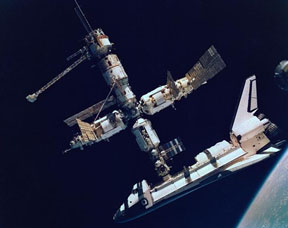Click on image for full size
Courtesy of NASA
Related links:
Russians Say Good-Bye to Mir
News story originally written on August 30, 1999
After 13 long years orbiting the Earth, the space station Mir has finally said good-bye to its last crew. The two cosmonauts along with one French astronaut landed on Earth, leaving the Mir uninhabitated for the first time in years. The Mir station was the world's space house for 3,641 consecutive days, which means this is the first time that no one has been in Earth's orbit since 1989.
"We went to the moon, but they elected to establish orbital space around the Earth as their domain, and Mir really is the culmination of that effort," said Jerry Grey, director of science and technology policy for the American Institute of Aeronautics and Astronautics.
A group of Russian scientists refuse to let the Mir go, and are still trying to raise money to keep it in operation. However, private investors haven't been found to cover the expensive price tag of $100 million. The group is currently lobbying in parliament, but the Russian government does not have any money to give the space station.
"It must become a national concern to prolong the life of the orbital complex, the pride of the Russian science," Nikolai Ryzhkov, one of the politicians that supports the station, said.
In the next six months, the spacecraft will slowly descend in Earth's atmosphere. In February or March of 2000, the station will be guided towards Earth and most of Mir will burn up. Some tv size chunks are expected to make it to the surface, so Russian scientists will bring down the station somewhere over the Pacific Ocean.















